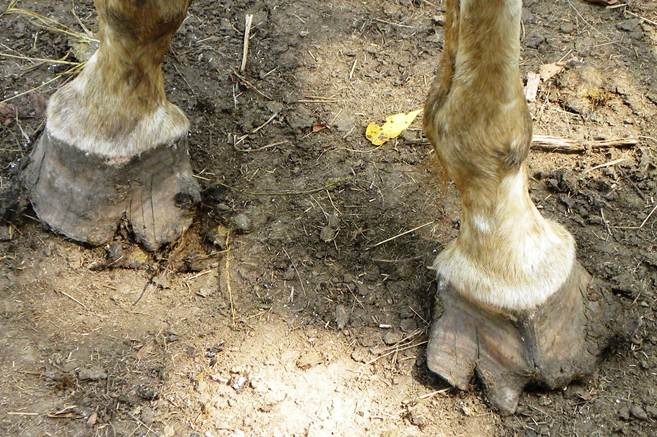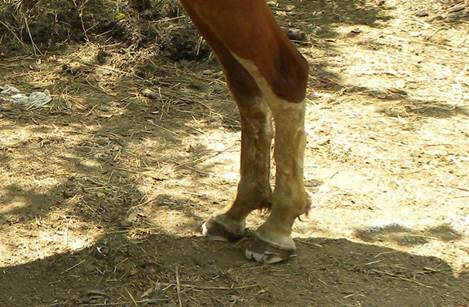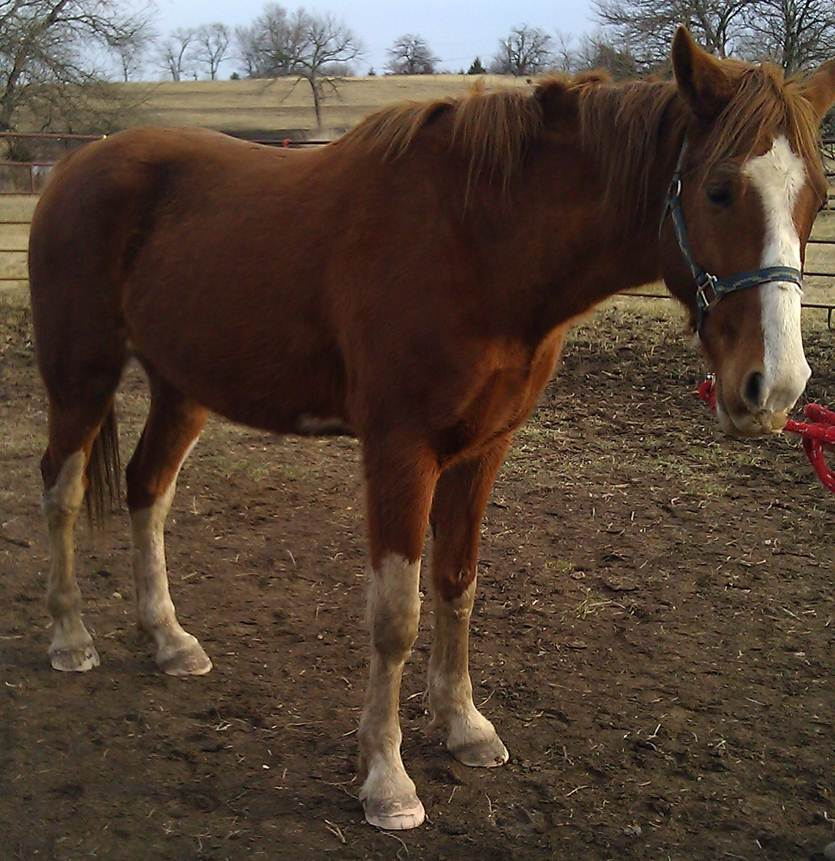Meet Mr. TThis horse was trimmed by Randy Billinger, the same great guy who gave Cody his life back. Here the story in Randyís words: He is one lucky horse as you will find out in this brief history of him. He was only a rain storm away from being euthanized. Mr. T. came to be owned by a couple who are good friends of mine, letís call them L and G. They called me to come look at his feet and see if they could be repaired. But before we get to his feet, a little background on Mr. T. and how L and G came to own him as I understand it. This is told second hand and is information I received from my friends L and G. Mr. T. was purchased at a horse sale by a caring person, a friend of L and G's. Mr. T. was on a truck headed for slaughter; he was not yet 3 years old. I do not know if his feet were in bad shape at the time of this purchase. However, as it turns out the person who saved Mr. T. was very caring but not horse knowledgeable. Sometime in their ownership of Mr. T. (I do not know how long they owned him) they had his feet checked. I am told second hand that they were told by both a farrier and a vet that it would be best to euthanize him because his feet were so bad they could not be repaired. This owner did not have a place to bury Mr. T. so they contacted L and G to see if they could bury Mr. T. out on their ranch. L and G have numerous horses of their own and foster numerous others until they can be placed in permanent homes. L and G were told the horse had to be euthanized due to chronic hoof problems so they had a grave dug and prepared to receive Mr. T. As it turns out, a very large thunderstorm hit that night with heavy rain and filled the grave with water and mud. Mr. T. arrived the next morning, so L and G agreed to take in this horse and keep it at the ranch until something could be decided, thus saving Mr. T. for now. At this same time, I was busy working on rehabbing a burro named Cody that had hoof problems. A few weeks after finishing with Cody's first trim, there began to be some talk about Cody's trim on a local chat group that L and G were on. They contacted me and asked if I would come look at Mr. T. I did not know they had Mr. T. nor did they know I had started doing rehab work on hooves so it was just good luck that we hooked up. I agreed to take a look and after hearing what L and G had to say about his feet I told them I was sure they could be fixed. The photos below are what I found when I saw Mr. T. for the first time. 
This is a photo of the front hooves. The hooves are severely split and disconnected. Examining these hooves most of the damage is simply from no hoof care and lack of movement. I think the horse was kept in a small area before arriving at L and G's ranch and did not have enough area to move and wear down his hooves naturally as they grew out. Combined with a lack of/or no proper hoof care, the results are clear. The hooves were trying to take care of themselves. The splits indicate the hooves grew long and the horse was not able to wear the walls down. The walls finally started to crack and in doing so made the problem worse. Now the hoof wall is divide into parts that are more flexible so instead of breaking off, these individual sections of the hoof wall simply continue to stretch and pull apart causing even greater splits and more lamellar separation. Once Mr. T. arrived at L and G's ranch, he had a large area (acres and acres) to move but still the long disconnected hoof wall did not break off. This shows there comes a point at which the hooves cannot heal themselves without help. Because there are numerous severe splits in each hoof dividing the hoof wall into individual flexible sections, I don't think the hoof would break off on its own. It would simply continue to grow disconnected and the lever forces would continue to pull apart the lamina keeping the horse in a chronic founder state. The overgrown material has to be cut off before healing can begin. The hooves are to a point that the horse cannot repair his feet on his own, plus the discomfort makes it extremely difficult for him to move comfortably and properly. Mr. T. was very sore on his right front foot. You can see in the photo that a very nasty split had migrated up into the cornet band and there is extreme flaring on the sides of the hoof. To make him more comfortable during the trimming process I laid down several layers of padding for him to stand his right front foot on. 
These are the back hooves. Again, numerous nasty splits and very disconnected hoof walls. Looking under all four of his feet, I found the sole and frog to be in very good shape. This reinforces my thoughts that his hoof problems stem from never being trimmed and lack of movement. He did have thin soles and was a good candidate for glue on boots, pads or castings but once the trim was completed, Mr. T. moved great and even trotted out. He was still tender on the right front, but L and G called a couple days later and said he showed great improvement and was out running with the other horses. I was very glad to hear that.  
Here are the hooves a couple hours later after the trim. I was able to remove the majority of the nasty splits and disconnected wall material. I was able to rasp out much of the flared wall. I trimmed Mr. T. very aggressively taking as much material as I could, yet leaving enough material around the toe and sole to support his weight while standing and help protect the thin sole. With the number of very severe splits and the degree of lamellar separation, I did not want to leave any material that might continue to pull apart the hoof wall. He did very well after the trim. 
Here is Mr. T. in February 2012. This is almost 2 years later. His splits are gone, he has a few new smaller cracks and some superficial cracks that are not causing any problems plus a couple chips in the walls from the many acres of rocky pasture he runs on. Most of this is due to the extremely dry winter we have had here in Kansas this year. There has been little moisture and horse and burro hooves in this area are dry, hard and brittle. I want to point out the nasty split he had in his right front hoof when I started trimming him. It is gone. The spot you see at the bottom of the toe is the remains of an abscess that developed probably from his hoof smacking a rock. It is dried up and healed but there is a weak spot in the hoof wall and when I was trimming him this day a piece broke out leaving the spot you see. When I first trimmed Mr. T., I did not know if that split would heal because it extended into the cornet band. I am very pleased that it has healed completely. Mr. T. is in good shape and very friendly. When he first arrived at L and G's place, he was underweight along with his bad feet. I have continued to trim Mr. T., well until just recently. Mr. T. has gone to a new home. L and G were keeping him until his hooves had recovered and until just the right person came along to adopt him. That happened in April 2012 so Mr. T. has a new young lady taking care of him. Mr. T. is a case that everyone should take to heart. His life was nearly cut short, first by slaughter then simply due to neglected hooves. I have had three cases recently in which an owner was told by a farrier that the hooves could not be repaired. I am not a professional farrier, I do not do this for a living. I learned to trim hooves because I wanted to know more about hooves and hoof internal structure. Plus I have 14 equines of my own, mostly mustangs, so it was financially smart for me to learn to take care of my own. I just want people to understand that hooves can be rehabbed and neglected hooves is not a reason to put an animal down. If you are reading this and you know an owner out there that has a horse or burro with bad feet and they have been told it's hopeless, reassure them it is not, they just need to locate the right natural hoof-hoof care practitioner. I would like to say thank you to the person who rescued Mr. T. from slaughter and to L and G for their dedication in saving Mr. T. the second time and seeing his hoof rehab through. And a big thanks to Mr. T. for sharing his feet with me and teaching more than I knew before. I'll miss taking care of your feet big guy. |